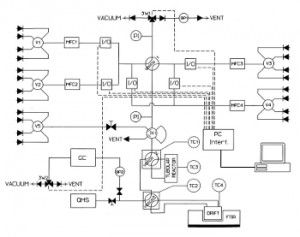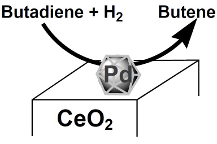Partial hydrogenation of dienes and alkynes is a reaction of great industrial importance. Butadiene is an impurity in C4 alkenes produced by cracking and butane/butadiene mixtures have to be purified before butene transformations, such as polymerization or alkylation processes.
Butene purification is actually performed by selective hydrogenation of butadiene. A good process will consequently work in such a way that the complete hydrogenation of butadiene into butenes takes place, while avoiding any butane formation. Palladium is still the reference catalytic metal for butadiene hydrogenation. However, it has been shown that its activity and selectivity can be strongly influenced by many factors like the metal dispersion, the nature of the support, and the preparation method. The improvement of selectivity still remains an important issue.
Butadiene selective hydrogenation is sensitive to the surface structure; the hydrogenation rate has been found to be more rapid with the more open (111) Pd face than with the close-packed (100) surface.
In this research program we have focused on the development of Pd catalysts by Pd(hfac)2 OM-CVD as an easy preparation method for palladium nanoparticles, of nanometric dimensional range, supported on different nanostructured oxides, namely ZnO, CeO2 and TiO2. Appropriate thermal pretreatments were used to tune the surface properties of the oxides with the aim of control the dispersion and, in some extent, the morphology of the supported Pd NPs. Surface and structural properties of the NPs were then characterized by means of infrared spectroscopy of adsorbed CO, a typical surface sensitive technique and by HR-TEM, which is instead a bulk technique.
The catalysts were then tested in butadiene traces selective hydrogenation, in order to reveal the different properties of supported metal nanoparticles using a fixed bed reactor flow testing rig connected downstream to an online quadrupole mass spectrometer (HPR-20 QIC gas analysis mass spectrometer system/Hiden Analytical Ltd.) for gas composition analysis.
 |
|
| Figure 1. Scheme of the testing rig (main parts: gas supply system, DRIFT cell inserted in FTIR, fixed-bed reactor stand, on-line QMS and GC.) | |
 |
| Figure 2. Reaction occurring on the most active catalyst (Pd/CeO2) |
| Project Summary by: Dr. Vladimiro Dal Santo CNR-ISTM Milan Italy |
 |
Paper Reference:
V. Dal Santo, A. Gallo , A. Naldoni, L. Sordelli (2012) “Selective butadiene hydrogenation by Pd nanoparticles deposed onto nano-sized oxide supports by CVD of Pd-hexafluoroacetylacetonate” Inorganica Chimica Acta 380, 216–222
Download PDF : Selective butadiene hydrogenation by Pd nanoparticles deposed onto nano-sized oxide supports by CVD of Pd-hexafluoroacetylacetonate
Visit Product Page : HPR-20 QIC R&D
Find out more : Send us a message

